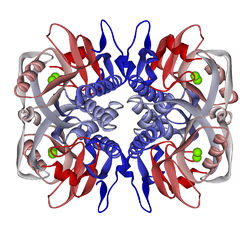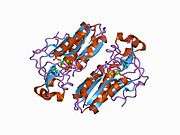Hypoxanthine-guanine phosphoribosyltransferase
| View/Edit Human | View/Edit Mouse |
Hypoxanthine-guanine phosphoribosyltransferase (HGPRT) is an enzyme encoded in humans by the HPRT1 gene.[3][4]
HGPRT is a transferase that catalyzes conversion of hypoxanthine to inosine monophosphate and guanine to guanosine monophosphate. This reaction transfers the 5-phosphoribosyl group from 5-phosphoribosyl 1-pyrophosphate (PRPP) to the purine. HGPRT plays a central role in the generation of purine nucleotides through the purine salvage pathway.
Function
| hypoxanthine phosphoribosyltransferase | |||||||||
|---|---|---|---|---|---|---|---|---|---|
| Identifiers | |||||||||
| EC number | 2.4.2.8 | ||||||||
| CAS number | 9016-12-0 | ||||||||
| Databases | |||||||||
| IntEnz | IntEnz view | ||||||||
| BRENDA | BRENDA entry | ||||||||
| ExPASy | NiceZyme view | ||||||||
| KEGG | KEGG entry | ||||||||
| MetaCyc | metabolic pathway | ||||||||
| PRIAM | profile | ||||||||
| PDB structures | RCSB PDB PDBe PDBsum | ||||||||
| Gene Ontology | AmiGO / EGO | ||||||||
| |||||||||
HGPRT catalyzes the following reactions:
| Substrate | Product | Notes |
|---|---|---|
| hypoxanthine | inosine monophosphate | — |
| guanine | guanosine monophosphate | Often called HGPRT. Performs this function only in some species. |
| xanthine | xanthosine monophosphate | Only certain HPRTs. |
HGPRTase functions primarily to salvage purines from degraded DNA to reintroduce into purine synthetic pathways. In this role, it catalyzes the reaction between guanine and phosphoribosyl pyrophosphate (PRPP) to form GMP, or between hypoxanthine and phosphoribosyl pyrophosphate (PRPP) to form inosine monophosphate.
Substrates and inhibitors
Comparative homology modelling of this enzyme in L. donovani suggest that among all of the computationally screened compounds, pentamidine, 1,3-dinitroadamantane, acyclovir and analogs of acyclovir had higher binding affinities than the real substrate (guanosine monophosphate).[5] The in silico and in-vitro correlation of these compounds were test in Leishmania HGPRT and validates the result.[6]
Role in disease
Mutations in the gene lead to hyperuricemia:
- Some men have partial (up to 20% less activity of the enzyme) HGPRT deficiency that causes high levels of uric acid in the blood, which leads to the development of gouty arthritis and the formation of uric acid stones in the urinary tract. This condition has been named the Kelley-Seegmiller syndrome.[7]
- Lesch-Nyhan syndrome is due to deficiency of HGPRT caused by HPRT1 mutation [8]
- Some mutations have been linked to gout, the risk of which is increased in hypoxanthine-guanine phosphoribosyltransferase deficiency.
- HPRT expression on the mRNA and protein level is induced by hypoxia inducible factor 1 (HIF1A). HIF-1 is a transcription factor that directs an array of cellular responses that are used for adaptation during oxygen deprivation. This finding implies that HPRT is a critical pathway that helps preserve the cell's purine nucleotide resources under hypoxic conditions as found in pathology such as myocardial ischemia.[9]
Creation of hybridomas
Hybridomas are immortal (immune to cellular senescence), HGPRT+ cells that result from fusion of mortal, HGPRT+ plasma cells and immortal, HGPRT− myeloma cells. They are created to produce monoclonal antibodies in biotechnology. HAT medium inhibits de novo synthesis of nucleic acids, killing myeloma cells that cannot switch over to the salvage pathway, due to lack of HRPT1. The plasma cells in the culture eventually die from senesence, leaving pure hybridoma cells.
See also
References
- ↑ "Human PubMed Reference:".
- ↑ "Mouse PubMed Reference:".
- ↑ "Entrez Gene: hypoxanthine phosphoribosyltransferase 1 (Lesch-Nyhan syndrome)".
- ↑ Finette BA, Kendall H, Vacek PM (Aug 2002). "Mutational spectral analysis at the HPRT locus in healthy children". Mutation Research. 505 (1-2): 27–41. doi:10.1016/S0027-5107(02)00119-7. PMID 12175903.
- ↑ Ansari MY, Dikhit MR, Sahoo GC, Das P (Apr 2012). "Comparative modeling of HGPRT enzyme of L. donovani and binding affinities of different analogs of GMP". International Journal of Biological Macromolecules. 50 (3): 637–49. doi:10.1016/j.ijbiomac.2012.01.010. PMID 22327112.
- ↑ Ansari MY, Equbal A, Dikhit MR, Mansuri R, Rana S, Ali V, Sahoo GC, Das P (Nov 2015). "Establishment of Correlation between In-Silico &In-Vitro Test Analysis against Leishmania HGPRT to inhibitors". International Journal of Biological Macromolecules. 83: 78–96. doi:10.1016/j.ijbiomac.2015.11.051. PMID 26616453.
- ↑ Khattak FH, Morris IM, Harris K (May 1998). "Kelley-Seegmiller syndrome: a case report and review of the literature". British Journal of Rheumatology. 37 (5): 580–1. doi:10.1093/rheumatology/37.5.580c. PMID 9651092.
- ↑ Hladnik U, Nyhan WL, Bertelli M (Sep 2008). "Variable expression of HPRT deficiency in 5 members of a family with the same mutation". Archives of Neurology. 65 (9): 1240–3. doi:10.1001/archneur.65.9.1240. PMID 18779430.
- ↑ Wu J, Bond C, Chen P, Chen M, Li Y, Shohet RV, Wright G (Feb 2015). "HIF-1α in the heart: Remodeling nucleotide metabolism". Journal of Molecular and Cellular Cardiology. 82: 194–200. doi:10.1016/j.yjmcc.2015.01.014. PMID 25681585.
Further reading
- Sculley DG, Dawson PA, Emmerson BT, Gordon RB (Nov 1992). "A review of the molecular basis of hypoxanthine-guanine phosphoribosyltransferase (HPRT) deficiency". Human Genetics. 90 (3): 195–207. doi:10.1007/bf00220062. PMID 1487231.
- Ansari MY, Dikhit MR, Sahoo GC, Das P (Apr 2012). "Comparative modeling of HGPRT enzyme of L. donovani and binding affinities of different analogs of GMP". International Journal of Biological Macromolecules. 50 (3): 637–49. doi:10.1016/j.ijbiomac.2012.01.010. PMID 22327112.
- Davidson BL, Tarlé SA, Van Antwerp M, Gibbs DA, Watts RW, Kelley WN, Palella TD (May 1991). "Identification of 17 independent mutations responsible for human hypoxanthine-guanine phosphoribosyltransferase (HPRT) deficiency". American Journal of Human Genetics. 48 (5): 951–8. PMC 1683055
 . PMID 2018042.
. PMID 2018042. - Stout JT, Caskey CT (1986). "HPRT: gene structure, expression, and mutation". Annual Review of Genetics. 19: 127–48. doi:10.1146/annurev.ge.19.120185.001015. PMID 3909940.
- Sege-Peterson K, Chambers J, Page T, Jones OW, Nyhan WL (Sep 1992). "Characterization of mutations in phenotypic variants of hypoxanthine phosphoribosyltransferase deficiency". Human Molecular Genetics. 1 (6): 427–32. doi:10.1093/hmg/1.6.427. PMID 1301916.
- Lightfoot T, Joshi R, Nuki G, Snyder FF (Mar 1992). "The point mutation of hypoxanthine-guanine phosphoribosyltransferase (HPRTEdinburgh) and detection by allele-specific polymerase chain reaction". Human Genetics. 88 (6): 695–6. doi:10.1007/BF02265300. PMID 1551676.
- Yamada Y, Goto H, Ogasawara N (1992). "Identification of two independent Japanese mutant HPRT genes using the PCR technique". Advances in Experimental Medicine and Biology. Advances in Experimental Medicine and Biology. 309B: 121–4. doi:10.1007/978-1-4615-7703-4_27. ISBN 978-1-4615-7705-8. PMID 1840476.
- Sculley DG, Dawson PA, Beacham IR, Emmerson BT, Gordon RB (Oct 1991). "Hypoxanthine-guanine phosphoribosyltransferase deficiency: analysis of HPRT mutations by direct sequencing and allele-specific amplification". Human Genetics. 87 (6): 688–92. doi:10.1007/BF00201727. PMID 1937471.
- Tarlé SA, Davidson BL, Wu VC, Zidar FJ, Seegmiller JE, Kelley WN, Palella TD (Jun 1991). "Determination of the mutations responsible for the Lesch-Nyhan syndrome in 17 subjects". Genomics. 10 (2): 499–501. doi:10.1016/0888-7543(91)90341-B. PMID 2071157.
- Gordon RB, Sculley DG, Dawson PA, Beacham IR, Emmerson BT (1991). "Identification of a single nucleotide substitution in the coding sequence of in vitro amplified cDNA from a patient with partial HPRT deficiency (HPRTBRISBANE)". Journal of Inherited Metabolic Disease. 13 (5): 692–700. doi:10.1007/BF01799570. PMID 2246854.
- Edwards A, Voss H, Rice P, Civitello A, Stegemann J, Schwager C, Zimmermann J, Erfle H, Caskey CT, Ansorge W (Apr 1990). "Automated DNA sequencing of the human HPRT locus". Genomics. 6 (4): 593–608. doi:10.1016/0888-7543(90)90493-E. PMID 2341149.
- Gibbs RA, Nguyen PN, Edwards A, Civitello AB, Caskey CT (Jun 1990). "Multiplex DNA deletion detection and exon sequencing of the hypoxanthine phosphoribosyltransferase gene in Lesch-Nyhan families". Genomics. 7 (2): 235–44. doi:10.1016/0888-7543(90)90545-6. PMID 2347587.
- Skopek TR, Recio L, Simpson D, Dallaire L, Melancon SB, Ogier H, O'Neill JP, Falta MT, Nicklas JA, Albertini RJ (Jun 1990). "Molecular analyses of a Lesch-Nyhan syndrome mutation (hprtMontreal) by use of T-lymphocyte cultures". Human Genetics. 85 (1): 111–6. doi:10.1007/BF00276334. PMID 2358296.
- Davidson BL, Tarlé SA, Palella TD, Kelley WN (Jul 1989). "Molecular basis of hypoxanthine-guanine phosphoribosyltransferase deficiency in ten subjects determined by direct sequencing of amplified transcripts". The Journal of Clinical Investigation. 84 (1): 342–6. doi:10.1172/JCI114160. PMC 303988
 . PMID 2738157.
. PMID 2738157. - Ogasawara N, Stout JT, Goto H, Sonta S, Matsumoto A, Caskey CT (Sep 1989). "Molecular analysis of a female Lesch-Nyhan patient". The Journal of Clinical Investigation. 84 (3): 1024–7. doi:10.1172/JCI114224. PMC 329751
 . PMID 2760209.
. PMID 2760209. - Yang TP, Stout JT, Konecki DS, Patel PI, Alford RL, Caskey CT (May 1988). "Spontaneous reversion of novel Lesch-Nyhan mutation by HPRT gene rearrangement". Somatic Cell and Molecular Genetics. 14 (3): 293–303. doi:10.1007/BF01534590. PMID 2835825.
- Fujimori S, Hidaka Y, Davidson BL, Palella TD, Kelley WN (May 1988). "Identification of a single nucleotide change in a mutant gene for hypoxanthine-guanine phosphoribosyltransferase (HPRT Ann Arbor)". Human Genetics. 79 (1): 39–43. doi:10.1007/BF00291707. PMID 2896620.
- Davidson BL, Pashmforoush M, Kelley WN, Palella TD (Jan 1989). "Human hypoxanthine-guanine phosphoribosyltransferase deficiency. The molecular defect in a patient with gout (HPRTAshville)". The Journal of Biological Chemistry. 264 (1): 520–5. PMID 2909537.
- Fujimori S, Davidson BL, Kelley WN, Palella TD (Jan 1989). "Identification of a single nucleotide change in the hypoxanthine-guanine phosphoribosyltransferase gene (HPRTYale) responsible for Lesch-Nyhan syndrome". The Journal of Clinical Investigation. 83 (1): 11–3. doi:10.1172/JCI113846. PMC 303636
 . PMID 2910902.
. PMID 2910902.
External links
- Hypoxanthine phosphoribosyltransferase at the US National Library of Medicine Medical Subject Headings (MeSH)
- Purine metabolism at genome.jp
- GeneReviews/NCBI/NIH/UW entry on Lesch-Nyhan Syndrome





